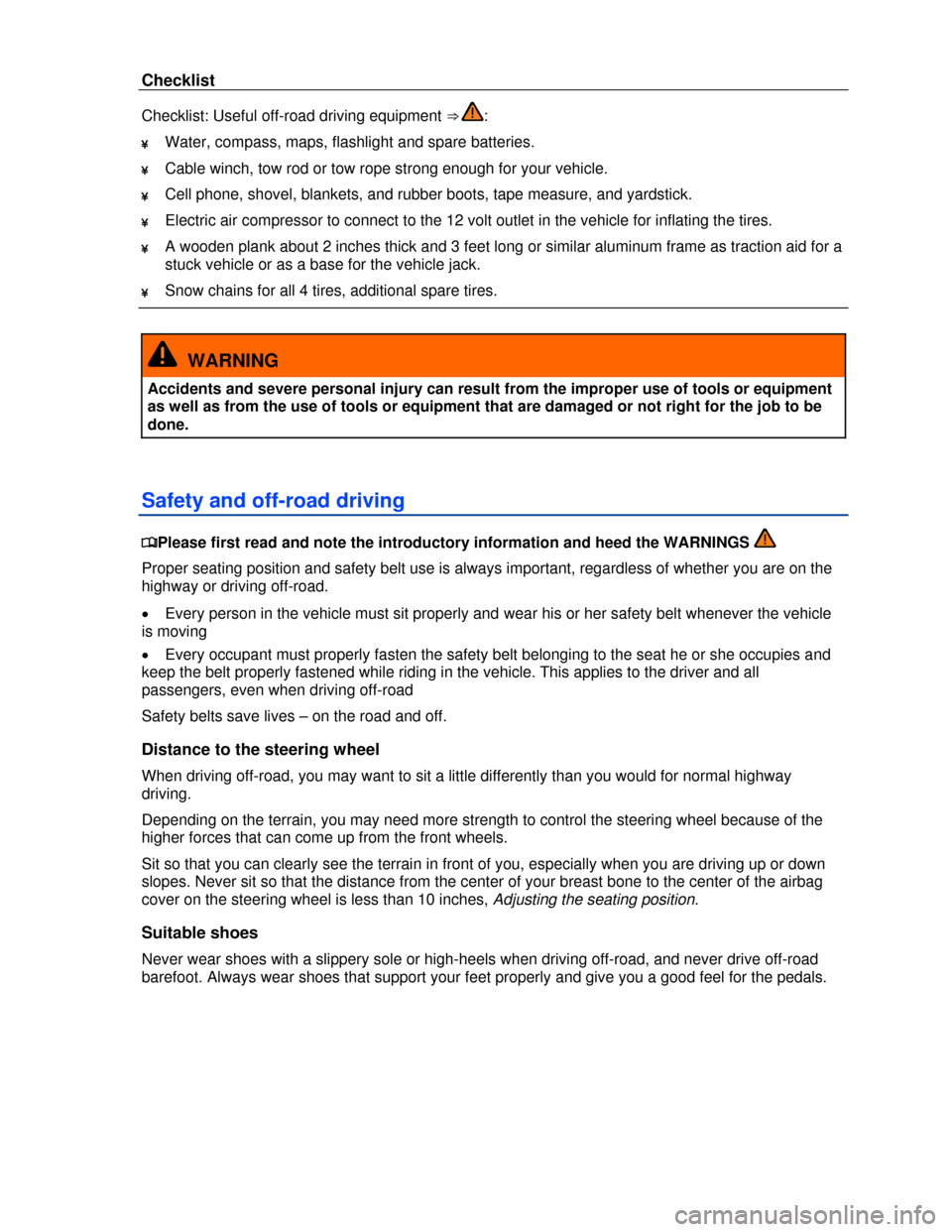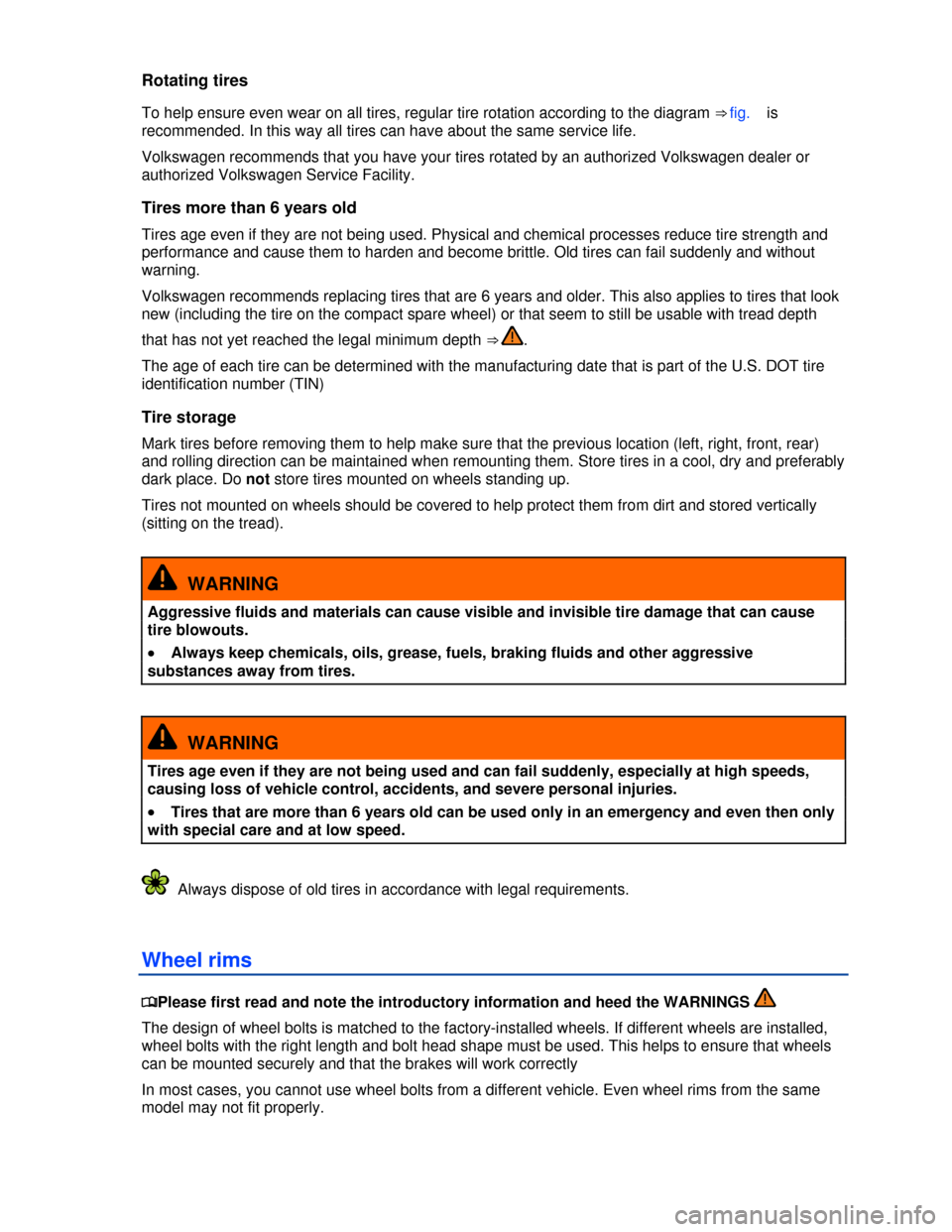2013 VOLKSWAGEN TIGUAN spare tire
[x] Cancel search: spare tirePage 230 of 356

Your vehicle has also been equipped with a TPMS malfunction indicator to indicate when the system
is not operating properly. The TPMS malfunction indicator is combined with the low tire pressure
telltale. When the system detects a malfunction, the telltale will flash for approximately one minute and
then remain continuously illuminated. This sequence will continue upon subsequent vehicle start-ups
as long as the malfunction exists.
When the malfunction indicator is illuminated, the system may not be able to detect or signal low tire
pressure as intended. TPMS malfunctions may occur for a variety of reasons, including the installation
of replacement or alternate tires or wheels on the vehicle that prevent the TPMS from functioning
properly. Always check the TPMS malfunction telltale after replacing one or more tires or wheels on
your vehicle to ensure that the replacement or alternate tires and wheels allow the TPMS to continue
to function properly.
Resetting and recalibrating the benchmark tire pressure
Resetting the tire pressures in the Multi-function Indicator (MFI) resets the benchmark tire pressure
used by the TPMS to the current tire pressure in the tires based on the circumference of the tires.
To reset the reference tire pressure, switch on the ignition. In the MFI, navigate to the Settings menu
and select Tire pressure. Store and confirm the new tire pressures.
The re-calibration must be performed each time the tire pressure in one or more tires has been
adjusted or after one or more tires has been changed, exchanged, or repaired. The new tire pressures
are stored in the system only after at least 20 minutes of normal driving.
If you have reset the benchmark tire pressure when your tires do not have the correct tire pressure,
this will prevent the TPMS from working properly. It may then give false warnings or may not give any
warning even if the tire pressure is too low.
For this reason, it is vital to make certain that all four tires are inflated to the correct pressure
when they are cold, before calibrating the system. Cold tire tires are tires that have not been driven
more than a couple of miles (kilometers) at low speed within the last 3 hours.
Recalibrate the system to reset the benchmark TPMS pressure in the following
situations:
�x After installing tires on your vehicle that have recommended cold tire inflation pressures that are
different from the tires that were taken off.
�x After any tire on your vehicle is removed and then remounted, even if the same tire and wheel rim
that were taken off are reinstalled (for instance, after repair).
�x After any tire on your vehicle is changed and replaced by another tire, even if the replacement tire
is the same type and is inflated to the same pressure as the tire it replaced.
�x After adjusting the tire pressure of any tire on the vehicle to its correct cold tire inflation pressure,
either by putting air in one or more tires or by letting air out. Do this even though air was only added
(or let out) to bring the tire to the inflation pressure it should have had all along.
�x After rotating the front and rear wheels
�x After mounting the compact spare tire.
WARNING
Incorrect calibration can cause the TPMS to give false warnings or to give no warning despite
dangerously low tire pressures. Make certain the tire inflation pressure of all tires is correct
before calibrating the system.
Page 254 of 356

Checklist
Checklist: Useful off-road driving equipment ⇒ :
¥ Water, compass, maps, flashlight and spare batteries.
¥ Cable winch, tow rod or tow rope strong enough for your vehicle.
¥ Cell phone, shovel, blankets, and rubber boots, tape measure, and yardstick.
¥ Electric air compressor to connect to the 12 volt outlet in the vehicle for inflating the tires.
¥ A wooden plank about 2 inches thick and 3 feet long or similar aluminum frame as traction aid for a
stuck vehicle or as a base for the vehicle jack.
¥ Snow chains for all 4 tires, additional spare tires.
WARNING
Accidents and severe personal injury can result from the improper use of tools or equipment
as well as from the use of tools or equipment that are damaged or not right for the job to be
done.
Safety and off-road driving
�
Page 291 of 356

Rotating tires
To help ensure even wear on all tires, regular tire rotation according to the diagram ⇒ fig. is
recommended. In this way all tires can have about the same service life.
Volkswagen recommends that you have your tires rotated by an authorized Volkswagen dealer or
authorized Volkswagen Service Facility.
Tires more than 6 years old
Tires age even if they are not being used. Physical and chemical processes reduce tire strength and
performance and cause them to harden and become brittle. Old tires can fail suddenly and without
warning.
Volkswagen recommends replacing tires that are 6 years and older. This also applies to tires that look
new (including the tire on the compact spare wheel) or that seem to still be usable with tread depth
that has not yet reached the legal minimum depth ⇒ .
The age of each tire can be determined with the manufacturing date that is part of the U.S. DOT tire
identification number (TIN)
Tire storage
Mark tires before removing them to help make sure that the previous location (left, right, front, rear)
and rolling direction can be maintained when remounting them. Store tires in a cool, dry and preferably
dark place. Do not store tires mounted on wheels standing up.
Tires not mounted on wheels should be covered to help protect them from dirt and stored vertically
(sitting on the tread).
WARNING
Aggressive fluids and materials can cause visible and invisible tire damage that can cause
tire blowouts.
�x Always keep chemicals, oils, grease, fuels, braking fluids and other aggressive
substances away from tires.
WARNING
Tires age even if they are not being used and can fail suddenly, especially at high speeds,
causing loss of vehicle control, accidents, and severe personal injuries.
�x Tires that are more than 6 years old can be used only in an emergency and even then only
with special care and at low speed.
Always dispose of old tires in accordance with legal requirements.
Wheel rims
�
Page 294 of 356

Drive train Tire dimensions Tire pressures
psi kPa bar
/50 R18 38 2.6
/40 R19 41 2.8
T /80 R185 61 4.1
xl = reinforced sidewall.
The Tire Pressure Monitoring System is configured at the factory with the correct tire inflation
pressure applicable for the vehicle model, engine and factory-installed tires. The tire inflation
pressure is listed on the tire inflation pressure label on the driver door jamb 289. The tire inflation
pressures for the road tires are listed on this label. The inflation pressure for the compact spare is as
specified on the tire pressure label or on a separate label for the compact spare, if there is one. In
the event of a discrepancy between the above figures and the tire pressures listed on the tire
inflation pressure label, the pressures listed on the label are the ones you should use.
Tread depth and tread wear indicators
Fig. Tread pattern: Wear indicator.
�
Page 296 of 356

WARNING
Unusual vibrations or pulling to one side can indicate tire damage.
�x Reduce speed immediately and stop when it is safe to do so.
�x Check tires and wheel rims for damage.
�x Never drive with a damaged tire or rim. Get expert assistance instead.
�x If no external damage is visible, slowly and carefully drive to the nearest authorized
Volkswagen dealer or authorized Volkswagen Service Facility or other qualified workshop
and have the vehicle checked.
Compact spare wheel
Fig. In the luggage compartment: Compact spare wheel.
Fig. In the luggage compartment: Held in place with a retainer.
�
Page 297 of 356

Stowing the replaced wheel
One of the vehicles normal wheels will not fit in the well for the compact spare wheel in the floor of the
luggage compartment. Therefore, in the event of a flat tire, the wheel which was changed must be
secured, for example, with suitable straps in the luggage compartment.
Open the rear hatch, raise the entire luggage compartment floor, press the retaining pin (1) to the right
and slowly lower the luggage compartment floor.
Put the wheel you took off the vehicle into the spare wheel well so that the center hole of the rim is
aligned with the threaded pin.
Turn the threaded retainer in the center of the compact spare wheel (2) clockwise until the wheel
replaced is securely in place.
If necessary, return the vehicle tool kit to its location in the luggage compartment.
Raise the floor covering and release the retaining pin, then fold the floor covering back down onto the
floor of the luggage compartment.
Close the rear hatch.
Differences between the road tires and the compact spare
The compact spare is different in design from the road tires and must be used only in the event of a
flat tire, only for a brief time, and only when driving with extra caution ⇒ .
Replace it with a tire matching the others on your vehicle as soon as possible.
Please heed the following:
�x Do not drive faster than 50 mph (80 km/h)!
�x Avoid full-throttle acceleration, hard braking and fast cornering!
�x Do not use snow chains on the compact spare wheel
�x After installing the compact spare tire, check the tire pressure as soon as possible
Check the tire inflation pressure of the compact spare whenever you check the tire pressure of the
road wheels, at least once a month. Inflate a compact spare tire to the cold tire pressure specified for
the compact spare on the tire pressure label or on a separate label for the compact spare, if there is
one.
Page 298 of 356

WARNING
Improper use of a compact spare tire can cause loss of vehicle control, a crash or other
accident, and serious personal injury.
�x Never use a compact spare tire if it is damaged or worn down to the wear indicators.
�x In some vehicles, the compact spare tire is smaller than the original tire. A smaller
compact spare tire is identified with a sticker and the words “50 mph” or “80 km/h”. This is
the maximum permissible speed when driving with this tire.
�x Never drive faster than 50 mph (80 km/h) with a compact spare tire. Avoid full-throttle
acceleration, heavy braking, and fast cornering!
�x Never drive more than miles ( km) if a compact spare wheel is installed on the front axle
(drive axle).
�x Replace the compact spare with a normal wheel and tire as soon as possible. Compact
spare tires are designed for brief use only.
�x Regularly check the U.S. DOT Tire Identification Number (TIN) to determine the age of the
compact spare tire
�x Tires age even if they are not being used and can fail suddenly, especially at higher
speeds.
�x Tires that are more than 6 years old can only be used in an emergency and then with
special care and at low speeds.
�x The compact spare tire must always be secured with the wheel bolts provided by the
factory.
�x Never drive using more than one compact spare wheel.
�x After installing the compact spare tire, the tire pressure must be checked as soon as
possible
�x Snow chains cannot be used on the compact wheel tire. If you must use snow chains and
have a compact spare wheel mounted, move the compact spare tire to the rear axle if a front
tire has to be replaced. The tire taken off the rear axle can then be used to replace the flat
front tire. Be sure you do not change the tire's direction of rotation. Install the snow chains
on the full-sized road tire.
NOTICE
When the spare wheel or compact spare is being used, the TPMS indicator light can start
flashing after about 10 minutes.
If possible, attach the compact spare tire or the tire you took off the vehicle securely in the
luggage compartment.
Page 311 of 356

WARNING
Inappropriate spare parts and accessories as well as unprofessionally performed work,
modifications and repairs can cause vehicle damage, accidents and serious personal
injuries.
�x Volkswagen strongly recommends to only use accessories approved by Volkswagen and
Genuine Volkswagen Parts®. These parts and accessories have been evaluated by
Volkswagen for their suitability, reliability and safety.
�x Have repairs and vehicle modifications performed by an authorized Volkswagen dealer or
authorized Volkswagen Service Facility. Authorized Volkswagen dealers and authorized
Volkswagen Service Facilities have the required tools, diagnostic equipment, repair
information, and trained personnel to properly replace any airbag in your vehicle and assure
system effectiveness in a crash.
�x Only install parts on the vehicle that are consistent with factory-installed parts with
respect to design and characteristics.
�x Never store, mount or attach objects, such as cup or phone cradles, on or next to the
airbag module covers or within the airbags deployment zones.
�x Only use wheel rim/tire combinations approved by Volkswagen for the respective vehicle
type.
Break-in period
�